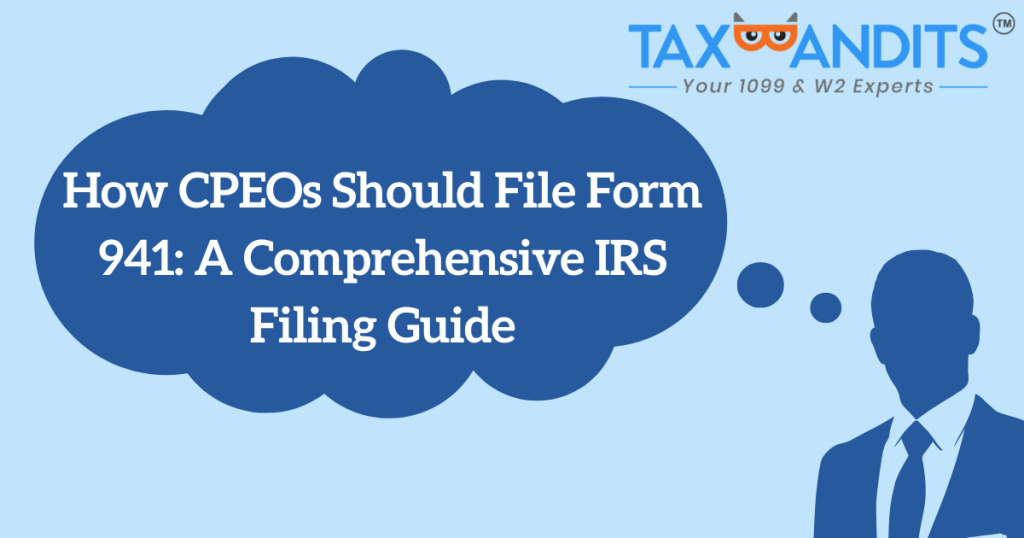How CPEOs Should File Form 941: A Comprehensive IRS Filing Guide
reading time: 15 minute(s)

Certified Professional Employer Organizations (CPEOs) play a critical role in simplifying employment responsibilities for their client businesses. From handling payroll and employee benefits to ensuring federal tax compliance, CPEOs take on a range of duties under a co-employment arrangement.
One of the most important quarterly tasks for CPEOs is filing Form 941, the Employer’s Quarterly Federal Tax Return. However, the filing process for CPEOs differs significantly from traditional employers. Additionally, CPEOs must file Schedule R (Form 941) to report the information from all their clients, adding to the CPEO compliance to-do list.
It is crucial to file aggregate Form 941 and Schedule R on time and accurately for IRS compliance to maintain clients’ trust and satisfaction. So, let’s take a look at what CPEOs need to know about 941 filing.
Understanding CPEO: In a Nutshell
First, let’s examine what a CPEO is and their overall responsibilities. A Certified Professional Employer Organization (CPEO) is a specialized company that partners with businesses to manage employment-related responsibilities—such as payroll, tax filings, benefits, and HR compliance—under a co-employment model.
Key responsibilities of a CPEO
- IRS Certification & Eligibility
To operate as a CPEO, an organization must be certified by the IRS. This confirms financial stability and compliance capability and allows the CPEO to file employment taxes under its own Employer Identification Number (EIN). - Establishing Client Relationship (Form 8973)
Once a client engages with a CPEO, the CPEO must file Form 8973 to notify the IRS of new or terminated client contracts. This step is essential before filing returns on behalf of any client. - Payroll & Benefits
The CPEO runs payroll, manages benefit deductions, and ensures compliance with federal employment requirements across all client workforces. - Federal Tax Filing & Deposits
CPEOs file employment tax forms (like Form 941 and 940) in aggregate using their own EIN and are responsible for timely deposits via EFTPS.
Key IRS forms filed by CPEOs
| Form | Purpose |
|---|---|
| Schedule R (Form 941) | Reports quarterly employment taxes; Schedule R breaks down client-level liability. |
| Schedule R (Form 940) | Reports annual FUTA liability; Schedule R allocates totals by client. |
| Schedule R (Form 943) | Filed for agricultural clients (if applicable); Schedule R allocates totals by client. |
| Form W-2 | Issued by the CPEO to report employee wages and withholdings. |
Filing Form 941 as a CPEO
Filing Form 941 as a CPEO means taking full responsibility for reporting all federal employment taxes for your clients under your own EIN. Here’s what this entails:
Filing requirements
- Use your EIN: File one aggregate Form 941 for all clients and your internal employees.
- Report accurately: Include total wages paid, federal income tax withheld, and both employer and employee portions of Social Security and Medicare taxes.
- Include Schedule R: Use Schedule R to allocate the reported liabilities to each client.
What to report
- Wages and tips paid
- Withheld federal income tax
- Social Security and Medicare taxes (both employer and employee shares)
- Any adjustments for fractions of cents, sick pay, tips, and group-term life insurance
You do not file separate 941s for each client—the CPEO’s EIN is the only one that appears on the return.
Schedule R (Form 941) Filing
Schedule R (Form 941) is a required attachment when a CPEO files an aggregate Form 941. Since the main return includes totals for all clients, Schedule R provides:
- A breakdown of wages and tax liabilities by client
- Each client’s EIN, payroll details, and allocated amounts for Social Security, Medicare, and withheld income taxes
- Transparency for accurate IRS crediting
As a CPEO, you are required to list each client’s legal name and EIN, along with the respective amounts of wages, federal income tax withheld, and Social Security and Medicare taxes. This allocation allows the IRS to trace each portion of the aggregate filing back to the correct client.
If you manage more than five clients, Schedule R Continuation Sheets must be attached to include the full list. The accuracy of this information is essential—any errors in allocation or client details may lead to delays or rejection of your return.
Filing Methods
As a CPEO, you must electronically file Form 941 and Schedule R, unless you are in the first calendar quarter of your CPEO certification, when paper filing is still allowed.
You must ensure that all attached schedules (e.g., Schedule R) are complete and submitted in the proper format.
Making Tax Deposits
All tax deposits must be made under the CPEO’s EIN using the Electronic Federal Tax Payment System (EFTPS). The CPEO must follow the IRS-determined deposit schedule (Monthly or semi-weekly) based on its total accumulated liability.
Since clients do not see these deposits reflected in their own EFTPS accounts, communication and transparency with clients are crucial.
Fixing Errors: Form 941-X
To correct previously filed Form 941 data, you can file Form 941-X to report adjustments and include a corrected Schedule R showing changes only for the impacted clients
This segmented correction process allows the IRS to track changes without requiring full resubmission of unaffected data.
Final Thoughts
As a CPEO, you have a lot of responsibilities when it comes to Form 941 filing, and with so many boxes to check, it can be a daunting task. This is especially the case when you have your workflow scattered across multiple filing methods and programs.
That’s why TaxBandits offers a streamlined filing solution with features like client and team management, bulk data uploads, flexible tax payments, and more. Keep your Form 941 filing streamlined and sign up today!


Leave a Comment